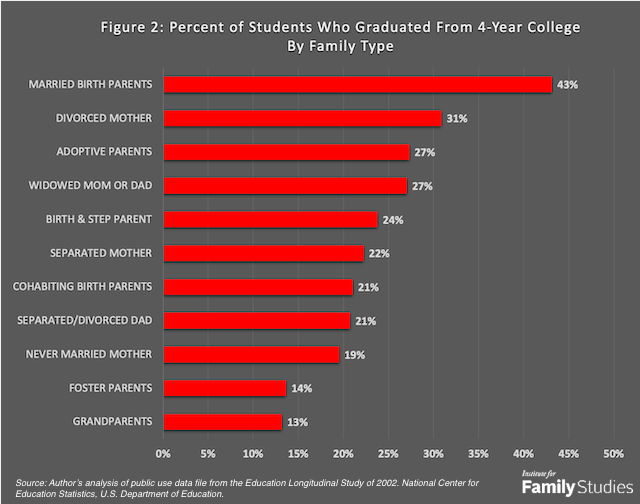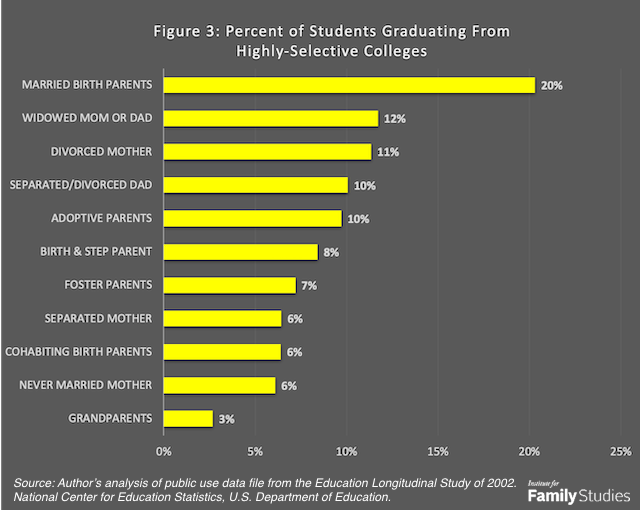Highlights
- The majority of students living with divorced or widowed mothers attended college. Post This
- Students who lived with their married birth parents were twice as likely to graduate from a selective college as students with widowed or divorced mothers. Post This
- Income differences do not seem to be the explanation for the higher degree attainment rates of students with divorced or widowed mothers. Post This
The 2020 senior classes in American high schools and colleges are graduating in a strange time. Virtual graduation ceremonies are replacing in-person gatherings out of fear of viral contagion. Graduates face a fall college semester full of uncertainties and a severely depressed job market.
Many political figures continue to call for free college for everyone. Yet the cost of tuition and board is not the only obstacle to a student from a low-income or minority family getting into college and completing the coursework required to earn a bachelor’s degree. When open enrollment policies have been tried by colleges, large proportions of “at risk” students turned out to need remedial instruction, and few managed to graduate with a 4-year degree.
When this has occurred, many have placed the blame on “poor performing” high schools and urged reforms to improve school efforts to prepare students for college. But those who seek to bolster achievement need to also pay attention to the role of families. Even without knowing anything about the specific high schools that a group of students have attended, one can do quite a good job of predicting which students will get college degrees and which ones will not. In fact, it is more informative to know about the family the student comes from, than the school to which he or she goes. Of course, it is also very helpful to know how well the student has done in high school in terms of grades and tested achievement.
We tend to think of the various forms of single-parent families—those headed by separated or divorced mothers, never-married mothers, widowed mothers, or by fathers rather than mothers—as all alike, and all equally disadvantaged. And indeed, all these varieties of single-parent families do have lower average incomes than families with two married birth parents. Yet when it comes to putting kids through college, there are significant differences among these family forms. As shown below, children who grow up with a divorced or widowed mother are more likely to attend and graduate from a 4-year college than children who grow up with a separated or never-married mother, or with a separated, divorced, or never-married father.
The reasons for the differences have partly to do with the characteristics of the women and men who wind up as divorced or widowed parents as opposed to separated or never-married parents, and with the financial and cultural circumstances in which children in these different family types are raised. But they also have to do with the continued participation of the non-resident parent in the child’s life, and the supports and safeguards that our social and legal institutions provide for some types of families but not others.
Before examining these reasons in greater detail, let me demonstrate that there are, in fact, differences in college outcomes among different forms of single-parent (and, for that matter, two-parent) families. For this purpose, I turned to data from a nationwide longitudinal study conducted by the U.S. Department of Education beginning in 2002.1 The study followed a probability sample of some 13,000 high school sophomores over a 10-year period, from 2002 to 2012, gathering information on how the students did with respect to their educational attainments after high school. The survey team made use of several different data sources, including student, parent, and teacher questionnaires, direct assessment of student knowledge and skills, and high school and college transcripts.
I carried out a fresh analysis of data from this study, focusing on the schools attended and degrees received by students from each of the single-parent groups enumerated above, as well as students who grew up with married birth parents, cohabiting birth parents, a birth parent and a stepparent, adoptive parents, foster parents, and grandparents or other relatives. My analysis also made use of data on parent education and family income levels, the sex and race and Hispanic origin of the student, as well as the student’s high school grade point average (GPA) and his or her composite score on tests of reading and math achievement administered while the student was in high school.
The Majority of Students Living with Divorced or Widowed Mothers Attended College
Overall, 58% of the national sample of high school sophomores in 2002 attended a 4-year college during some portion of their post-high school careers. Attendance rates varied substantially across family types, however, as shown in Figure 1. Two-thirds of students from married birth parents families attended college, a significantly higher proportion than nearly all of the other family types. Well over half of those living with widowed mothers or fathers2 or with divorced mothers attended, while barely half of those living with separated mothers did so. Less than half of students living with never-married mothers or single fathers ever went to a 4-year college.
Attending a college is not the same as completing four years of required coursework and earning a degree. The overall graduation rate was 56% of those who attended, but in only two groups was the rate over half: for students with married birth parents and those living with divorced mothers. The graduation rate was under half for all the other family types, with the lowest rates for students raised by grandparents and foster parents.

More Than a Quarter of Students with Divorced or Widowed Mothers Earned Degrees
One third of all students earned four-year degrees, with the highest rate among students raised by married birth parents, as shown in Figure 2 below. Their college degree attainment rate was significantly higher than those for students in all other family groups. More than a quarter of students living with divorced mothers and widowed mothers or fathers earned degrees. The rate for students with divorced mothers was significantly higher than those for students living with separated mothers and never married mothers, as well as those with separated or divorced fathers, birth and stepparents, and even cohabiting birth parents. Students with adoptive parents also had a relatively high degree attainment rate, especially in comparison with students being cared for by foster parents or grandparents or other relatives.

The type of family from which the student came was also related to the student’s chances of graduating from a highly selective college; i.e., one whose first-year students’ test scores placed the school in the top fifth of baccalaureate-granting institutions.3 As shown in Figure 3, students who lived with their married birth parents were twice as likely to graduate from a selective college as students with widowed or divorced mothers. And students from the latter groups were twice as likely to graduate from such a college as students with separated or never married mothers.

Income Disparities Do Not Explain the Differences
In seeking an explanation for the higher college completion rates of students from divorced and widowed families, I examined disparities among the single-parent groups in family income and parent education levels, and in their racial and ethnic composition.
In general, students from families with higher income levels are more likely to attain college degrees.4 But income differences do not seem to be the explanation for the higher degree attainment rates of students with divorced or widowed mothers. Although there were income differences, they were not major ones. The median family income in 2001 for the divorced mother group was $29,150, compared with $27,050 for the separated mother group and $24,675 for the never married mother group. The widowed mother or father group had a median income of $30,627. All of these income levels are low in comparison with the median family income for the married birth parents group, which was nearly twice as large: $60,437. Furthermore, the birth parent-stepparent group also had a substantially higher income level ($51,133), but a lower college completion rate.
Non-resident Fathers. What may be more important than the income disparities is that divorced mothers are more likely than separated or never-married mothers to have support agreements with the non-resident fathers of their children. Such agreements often call for the father to pay child support and all or part of college tuition and board. Similarly, widowed parents often receive payments from life insurance policies, pensions, or Social Security survivors benefits. These are regular and predictable sources of money and may include provisions for college costs.
Mother’s Education. Another factor that helps account for the disparities in college completion rates is that there were more divorced and widowed mothers than separated or never-married mothers who had college degrees themselves. Like family income, parent educational attainment is one of the strongest predictors of how far a child will go in school.5 Among students with divorced mothers, 41% had mothers with college degrees or more, as did 40% of students with widowed mothers or fathers. By comparison, among students with separated mothers, 28% had college degrees, as did 22% of students with never married mothers. Conversely, among students with separated or never married mothers, 37% had only a high school education or less. The same was true of only 20% of students with divorced mothers and 30% of those with widowed mothers or fathers.
Racial Differences. Still another factor relevant to the disparities in college completion rates is the racial and ethnic composition of the different single-parent groups.6 Families headed by divorced mothers or widowed mothers or fathers had higher concentrations of white and Asian students, while families headed by separated or never married mothers had higher concentrations of black and Hispanic students. Historically, black and Hispanic students have had lower achievement and attainment levels than white and Asian students. Even though the numbers of black and Hispanic students earning high school diplomas and college degrees have risen over the last half-century, racial and ethnic gaps have persisted.
But a problem with invoking racial composition as an explanation for the disparities is that the ethnic breakdown of the birth parent-stepparent group and the separated or divorced father group were similar to those of the divorced and widowed groups. Yet the stepparent and single father groups had lower college completion rates than the divorced and widowed groups.
Family Dynamics. It seems likely that the higher college completion rates of students from divorced and widowed families are at least partly attributable to differences in family dynamics. Students living with a divorced mother have experienced the stresses of interparental conflict and family disruption, to be sure. But, in most cases, they have not had the further life change of the mother’s remarriage, nor the strains of adjustment to a stepfather and stepsiblings. And by getting officially divorced, the parents have usually come to some sort of agreement specifying the living and schooling arrangements for the student and the custodial rights and obligations of each former partner. This provides more certainty and stability for the child than if the mother remains merely “separated” or if she never marries. And it increases the odds that the non-resident father will contribute to the student’s upbringing—and his or her support and educational expenses—in a meaningful way.
Students with a widowed mother or father have experienced the stress of the death of the other parent and the deprivation of that parent’s participation in their upbringing. But there is no presumption that interparental conflict occurred prior to the death. Furthermore, widowed parents often receive life insurance or pension payments or Social Security survivors benefits, as I noted earlier. Although these may not be as ample a source of support as the wages that a living parent could provide, they have the advantage of being a stable and predictable supplement to the earnings of the surviving parent.
What Family Factors Best Nuture College Students?
The results of my analysis support the premise that single-parent families are not all alike as far as getting a child into and through college to earn a bachelor’s degree or more. The multivariate analysis results indicate that the higher degree attainment rates for students with divorced mothers and widowed mothers or fathers are partly attributable to the higher parent education levels and differing racial composition of these groups. But parent education, family income, and racial composition do not account for the higher degree attainment rate of students with divorced mothers vis-à-vis those with remarried mothers or divorced, separated or never-married fathers. These higher attainment rates of students in the former group may be attributable to lower levels of family stress and greater support from the non-resident biological father.
What I have not emphasized that the results also show is that the best family situation for nurturing a college graduate is for both birth parents to get married, stay married, and raise the child together.7 Failing that, family arrangements that help ensure the continued participation of both parents in the child’s upbringing and minimize the number of disruptions and reconstitutions that the child must endure seem more favorable for the attainment of a degree. State and local laws and policies and practices that encourage and support such arrangements are likely to have beneficial effects on the educational attainment of future generations of students.
Nicholas Zill is a research psychologist and a senior fellow of the Institute for Family Studies. He directed the National Survey of Children, a longitudinal study that produced widely cited findings on children’s life experiences and adjustment following parental divorce.
Editor's note: For a PDF copy of the full research brief, go here.
1. https://nces.ed.gov/surveys/els2002/
2. Because of the small size of the widowed mother and widowed father subsamples, I combined them into a single group for these analyses.
3. The institutional selectivity measure was based on NCES’ Integrated Postsecondary Education Data System (IPEDS) and its “CCUGPROF” variable (Carnegie Classification 2010- Undergraduate Profile).
4. College degree attainment varied from 20% for students with family incomes of $20,000 or less to 51% for students with incomes of $100,000 or more, after adjusting for family type, parent education, race and ethnicity, and sex of student. (Appendix: Table Two, available upon request from author.)
5. College degree attainment varied from 17% for students whose parents had less than a high school diploma to 51% for those whose parents had a graduate or professional degree, after adjustment for family type, family income, race and ethnicity, and student sex. (Appendix: Table Two, available upon request from author.)
6. College degree attainment varied from 24% among Hispanic students to 49% among Asian students, after adjustment for family type, parent education, family income, and sex of student. (Appendix: Table Two, available upon request from author.)
7. W. Bradford Wilcox (April 2014). Dad and the Diploma: The Difference Fathers Make for College Grraduation. AEI Policy Brief. Washington, DC: American Enterprise Institute.














